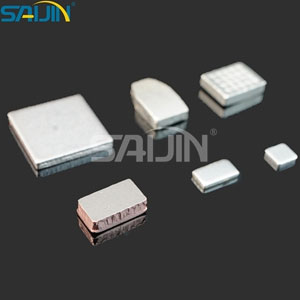Datatime: 11/30/2017 12:00:00 AM Visit: 1423
The advantages and disadvantages of three kinds of contact silver contacts:
Bridge-type composite silver contacts: bridge-type silver contacts of the two contact strings in the same circuit, the circuit is connected and disconnected by the two contacts together to complete.
Disadvantages: point contact with silver contacts in contact with the average pressure is large, easy to destroy the contact surface formed on the film, and poor heat dissipation. For small current, and the contact pressure of small occasions, such as relay circuits, auxiliary contacts.
Surface Contact Type Composite silver contacts: for high current applications, this contact is generally in contact with the surface of the alloy in order to reduce the contact resistance of the contact to improve wear resistance, and more for the larger capacity of the main contactor Contacts.
Finger-shaped contacts: contact the contact area is a straight line, contacts connected or broken rolling friction occurs, not only conducive to remove the oxide film, but also can cushion the contact closure of the impact energy, improve the electrical properties of contacts.

Apply to the power of the number of occasions, the larger current occasions, commonly used in knife switch.
Point contact composite silver contacts: Although the membrane resistance is small, but the heat dissipation area and heat capacity are small, so more than with a small current.
Surface contact: fixed contact often used in this form, and the use of screws or rivets such as pressure to increase the pressure, so that contact resistance decreases. As the surface area of the heat dissipation and heat capacity, and more for high current.
Line contact: the pressure concentration, the actual contact pressure strength, contact pressure in the medium pressure is small, the advantages of line contact can also be expressed in the closed contact in the process of relative movement and automatic purification, easy to adjust. So widely used in contactors, automatic switching and high voltage switch electrical contacts. Composite silver contacts are the most important part of composite silver. Their performance is strongly influenced by factors such as the material of the contacts, the applied voltage and current values (especially the voltage and current waveforms when the contacts are energized and de-energized), the type of load, the operating frequency, the atmospheric environment , Contact configuration and jitter. If any of these factors can not meet the predetermined value, problems such as metal electrodeposition between contacts, contact welding, abrasion, or rapid increase in contact resistance may occur.
Contact introduction
The so-called contact structure, refers to the contact mechanism. For example: b contact (Break contact), a contact (Make contact), c contact (Transfer contact) and so on.
Contact series
The so-called contact series is the number of contacts loop.
Contact mark
Each contact mechanism is represented in the following manner:
A contact (NO) b contact (NC) c contact (changeover) MBB contact
Relative to the domestic early statement: H (moving together, that is normally open contact), D (dynamic break, that is normally closed contact), Z (conversion contact)
Specification load
Determines the standard value of switch (contact) performance, expressed as a combination of contact voltage and current.
Determine the role
There are generally two types of contacts, control contacts and signal contacts. Control contact is 220V / 380V voltage power supply, usually in this loop then a smaller composite silver or other switch, that is closed the switch or composite silver, give the middle of the silver composite coil power supply, composite silver Pull. Signal contact from the feedback role, it can provide two states, closed off, so that other control circuit can determine whether the normal contactor pull.